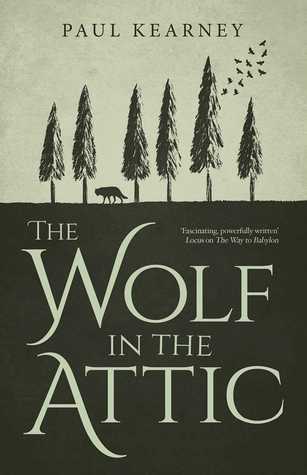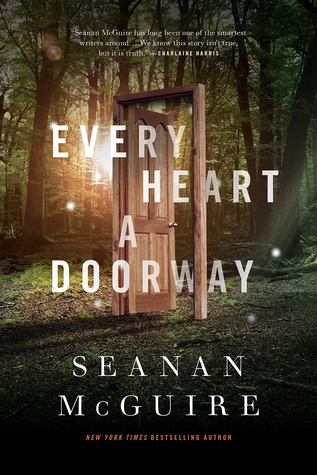The Wolf in the Attic is a novel about Anna, a refugee girl living in 1920s Oxford with her father. She only dimly remembers her life before the catastrophe that brought her to England, and, home-schooled by a governess, she does not have much contact with other children. Looking for an adventure, she sneaks out into the fields and forests around Oxford in the middle of the night, only to come face to face with something scarier than she'd ever expected, and people who seem to live more mythical, ruthless and dangerous lives.
The blurbs in some places mention CS Lewis and JRR Tolkien, who live in the same Oxford as Anna. Indeed, they make cameo appearances in the book. However, this isn't their story. Their appearances add very little to the plot. To be honest, I think it might have been wiser to cut them out entirely: mentioning Narnia or Tolkien will nudge reader expectations into certain directions. The Wolf in the Attic, however, is too different in its perspective.
Anna's encounters take place in our world. The strangers she meets may live differently, but they wander through the same landscapes and the same Britain that we live in. Don't think Narnia. Think Pan's Labyrinth, Alan Garner or some of the more restrained urban fantasy you might have read / watched. Meanwhile, Anna's adventures don't feel safe the way Narnia ones do, nor epic in the same way that Middleearth ones are.
Paul Kearney is a fascinating writer, tackling the intersection of the otherworldly with our own world with care and a lot of thought. He's written several novels for adults which handle such stories with more complexity than most: A Different Kingdom and Riding the Unicorn. The Wolf in the Attic is a novel for Young Adults, but it, too, thinks about the grittier aspects of its type of story. In his adult novels, the protagonists are a wife-beating prison guard and a man whose youthful adventures in another world leave him broken. In the Wolf in the Attic, our heroine is a not-entirely-welcome refugee girl with a difficult father, going through puberty (in all its sticky, inglorious detail). Make no mistake: this is no flimsy light entertainment. This is literary literature.
There's a lot to appreciate about this book: having a refugee as heroine is certainly timely - and a reminder that refugees come from all kinds of backgrounds and places. Anna's family are Greeks from Smyrna, which was burnt down and subjected to massacres and is now called Izmir: I had never even heard of Smyrna, so the book made me look things up and educated me about an aspect of history I'd been entirely ignorant of. As for the fantastical elements, they are evocative and primal, as they should be.
That said, at times I struggled to keep reading. It throws a few too many ideas into one story. Once you mix up several different archetypal strands, you lose the beautiful clarity that a single strand can add to a tale. This is the trap that The Wolf in the Attic falls into - too many myths and ideas produce a confusing brew of a novel. The cameos of legendary Oxfordian authors is one example of an ingredient that didn't quite fit. There are others, but they would be spoilers.
To be honest, I'd recommend Paul Kearney's earlier novels: their themes are more coherent and, though serious, they never dragged. The Wolf in the Attic is not a bad novel. It's clever and interesting and has a lot to recommend it. Sadly, the mix of ingredients is not quite right.
Rating: 3/5
Sunday, 27 March 2016
Wednesday, 23 March 2016
Book Review: Every Heart a Doorway by Seanan McGuire
Every Heart a Doorway is a much-anticipated YA novella about a magical boarding school for girls who've returned from adventures in fantastical worlds. Seanan McGuire, who also writes as Mira Grant, is known for writing original, quirky, fun novels, filled with witty characters who have snappy repartee. A bit like the original Scooby Gang in Buffy.
Right from the first glimpse of the cover, there's a sense that Every Heart a Doorway is aiming higher than usual. Seanan McGuire's stories are always fun and fast-paced, but this time, there's a sense that the author is not just aiming to entertain, but to write something memorable and touching and meaningful.
The premise interrogates common fantasy tropes the same way that, for example, The Rest of Us Just Live Here does. There's a real, intelligent engagement with the trope, taking the premise quite seriously. Many of the most iconic stories about kids entering fantasy worlds have young girls on the cusp of puberty / adulthood as their protagonists. (A fact which has inspired other authors to write pornography about these travelling girls). Unsurprisingly, one of the questions the story handles is the why and wherefore of this pattern. What does it say about our societies, and what does it say about girls?
But it wouldn't be a Seanan McGuire story if it just focused on meta-analysis and literary critique. Every Heart a Doorway is many things, but its plot engine is a serial killer murder mystery. You barely get time to adjust to this unique school and its memorable residents before gruesome murders start to occur. At the same time, our young characters grapple with issues of sexuality, asexuality and trans-sexuality, romance and love. Plus, of course, the all-consuming longing to find their ways back to those magical worlds where they found, temporarily, a real home for their true selves...
Every teenager in the story is quite self-absorbed, so when murders do occur, they do not grieve as much as I first expected. As much as the cover and title hint at a deep and emotive story, it turns out that these magical travellers are not quite able to connect with others. Their main motive in trying to solve the murders isn't justice, nor even their own safety, but preserving the independence of their school, so they can continue to have this friendly safe space to recover from the trauma of separation from their worlds. Survival is a secondary consideration. Justice does not feature at all. Perhaps the somewhat shallow connections between characters appear this way because our main protagonist is a goth girl who has only just returned from her fantasy world, and whose every instinct is to stand by, to be removed, to be background. She's completely uncomfortable about being dragged into the centre of a story. There are hints that other characters have stronger connections, but even so, there is a sense of hollowness about many of them: they may have returned from their worlds, but they have not returned unscathed.
Every Heart a Doorway is a story of longing, of not belonging, of friendship, of adolescence, and of murder. It's a novella that packs more ideas in its short length than many a full-length novel, while keeping the reader entertained with witty repartee and fast prose. Its main flaw is that it is far too quick: as a reader I wanted to spend more time in this world with these characters. I wanted the immersion to be richer, longer-lasting, deeper.
Rating: 4/5
Right from the first glimpse of the cover, there's a sense that Every Heart a Doorway is aiming higher than usual. Seanan McGuire's stories are always fun and fast-paced, but this time, there's a sense that the author is not just aiming to entertain, but to write something memorable and touching and meaningful.
The premise interrogates common fantasy tropes the same way that, for example, The Rest of Us Just Live Here does. There's a real, intelligent engagement with the trope, taking the premise quite seriously. Many of the most iconic stories about kids entering fantasy worlds have young girls on the cusp of puberty / adulthood as their protagonists. (A fact which has inspired other authors to write pornography about these travelling girls). Unsurprisingly, one of the questions the story handles is the why and wherefore of this pattern. What does it say about our societies, and what does it say about girls?
But it wouldn't be a Seanan McGuire story if it just focused on meta-analysis and literary critique. Every Heart a Doorway is many things, but its plot engine is a serial killer murder mystery. You barely get time to adjust to this unique school and its memorable residents before gruesome murders start to occur. At the same time, our young characters grapple with issues of sexuality, asexuality and trans-sexuality, romance and love. Plus, of course, the all-consuming longing to find their ways back to those magical worlds where they found, temporarily, a real home for their true selves...
Every teenager in the story is quite self-absorbed, so when murders do occur, they do not grieve as much as I first expected. As much as the cover and title hint at a deep and emotive story, it turns out that these magical travellers are not quite able to connect with others. Their main motive in trying to solve the murders isn't justice, nor even their own safety, but preserving the independence of their school, so they can continue to have this friendly safe space to recover from the trauma of separation from their worlds. Survival is a secondary consideration. Justice does not feature at all. Perhaps the somewhat shallow connections between characters appear this way because our main protagonist is a goth girl who has only just returned from her fantasy world, and whose every instinct is to stand by, to be removed, to be background. She's completely uncomfortable about being dragged into the centre of a story. There are hints that other characters have stronger connections, but even so, there is a sense of hollowness about many of them: they may have returned from their worlds, but they have not returned unscathed.
Every Heart a Doorway is a story of longing, of not belonging, of friendship, of adolescence, and of murder. It's a novella that packs more ideas in its short length than many a full-length novel, while keeping the reader entertained with witty repartee and fast prose. Its main flaw is that it is far too quick: as a reader I wanted to spend more time in this world with these characters. I wanted the immersion to be richer, longer-lasting, deeper.
Rating: 4/5
Subscribe to:
Posts (Atom)

